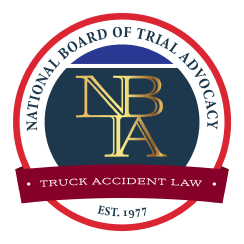Truck Driver Hours of Service in Utah
 Many people think of impaired drivers as only those under the influence of alcohol or drugs. Bur extreme fatigue can be just as dangerous, especially for drivers of large commercial trucks. According to the Centers for Disease Control and Prevention (CDC), the mental effects of prolonged sleep deprivation are similar to having a blood alcohol concentration above the legal limit.
Many people think of impaired drivers as only those under the influence of alcohol or drugs. Bur extreme fatigue can be just as dangerous, especially for drivers of large commercial trucks. According to the Centers for Disease Control and Prevention (CDC), the mental effects of prolonged sleep deprivation are similar to having a blood alcohol concentration above the legal limit.
The more tired the driver, the more dangerous they become. A tractor-trailer’s colossal size and weight make any fatigue-related error a potential disaster. Recognizing this danger, the Federal Motor Carrier Safety Administration (FMCSA) imposes strict hours-of-service regulations on truck drivers. These rules outline how long a trucker can remain on the road without rest. Obeying them can save lives.
If a drowsy truck driver hit you, someone in the trucking industry probably owes you money. Utah personal injury laws allow you to seek compensation from the at-fault party, and an experienced truck accident lawyer can help you obtain it.
The trusted attorneys at Swenson & Shelley dedicate each day to standing up for the wrongfully injured. Determining whether a truck driver violated hours-of-service rules requires collecting evidence that is not easy for private citizens to do. Our no-nonsense attorneys can step in and demand the proof we need to win your truck accident case. Call or contact us for a free consultation today.
Hours-of-Service Regulations for Large Commercial Trucks
FMCSA monitors and regulates the U.S. trucking industry. As part of its efforts to discourage drowsy driving and prevent crashes caused by driver fatigue in Utah, it mandates specific hours of service (HOS) regulations for commercial motor vehicle drivers:
- 11-hour driving limit – Under this rule, commercial drivers cannot drive for more than 11 hours following 10 consecutive hours off duty.
- 14-hour on-duty limit – This regulation forbids truckers from driving beyond the 14th consecutive hour after coming on duty following 10 straight hours off duty
- 30-minute break requirement – Hours-of-service rules require truck drivers to take breaks for at least 30 consecutive minutes any time they have driven for eight cumulative hours without at least 30 minutes of uninterrupted rest time.
- 60/70-hour per week limit – Truckers cannot drive more than 60 hours within a seven-day period or more than 70 hours within a consecutive eight-day period. The clock only resets if truckers take at least 34 consecutive hours off-duty.
There are exceptions to these rules, including one that allows drivers to extend their drive time and on-duty windows by up to two hours in adverse driving conditions. Short-haul drivers who operate within a 150-mile radius are also exempt from specific regulations, and there are slightly different HOS limits for commercial drivers who transport passengers rather than freight.
Which Trucking Regulations Are Broken the Most Often?
In addition to HOS regulations, here are other federal trucking regulations that drivers and trucking companies violate most frequently:
- Maintenance requirements – Owners and operators of commercial trucks are required to inspect, maintain, and repair their vehicles routinely.
- Utah Cargo loading regulations – A truck’s cargo must be properly balanced, well-secured, and within maximum weight limits.
- Driver screening requirements – To meet FMCSA requirements, drivers must be commercially licensed, drug tested, and medically fit to drive.
- Recordkeeping requirements – Trucking companies and drivers must keep detailed records of maintenance, drive time, and rest time.
How Hours-of-Service Regulations Impact Trucking Accidents
When truck drivers violate HOS rules independently or because their employers encourage unsafe driving practices, innocent people can get hurt. If a truck driver violated federal HOS regulations, you might be able to hold them or their employer liable for injuries you sustained in a crash. An attorney can help you obtain truck driver or trucking company records and identify which violations occurred.
With a successful drowsy driving truck accident claim, the at-fault party in Utah could owe you compensation for:
- Medical bills
- Lost wages and benefits
- Projected value in lost earning capacity
- Rehabilitation
- Pain and suffering
- Lost quality of life
- Lost enjoyment of life
- Permanent disfigurement
- Property damage
How to Prove Hours-of-Service Violations
The legal team at Swenson & Shelley can prove an hours-of-service violation occurred by obtaining evidence in Utah such as:
- Truck driver log – Truckers must maintain a trip log detailing their stops and rest periods. The log alone cannot be a definitive piece of evidence because it could be falsified or incomplete. However, it can help as the investigation gets underway.
- Electronic logging devices – A commercial motor vehicle equipped with an electronic logging device (ELD) helps companies track and monitor their drivers. If ELD records do not match a driver’s written log, lawyers and insurance companies may question their credibility..
- Receipts – Stops for gas or food may be recorded on timestamped receipts. These can be compared to other records of the driver’s shift to see if an hours-of-service violation occurred.
- Witness statements – Eyewitnesses may have seen the truck driver exhibit signs of drowsy driving before the crash and can testify to support your claim in Utah.
- Cell phone and GPS data – This information may help reconstruct where and what the truck driver was doing in the period before the wreck.
Let a Skilled Utah Truck Accident Attorney Help You
If you were injured in a truck accident due to truck driver fatigue, an accomplished truck accident attorney from Swenson & Shelley can demand justice and accountability for you. Let us fight for the compensation you deserve. Call or contact us online to discuss the details of your case during a free consultation.
Were you seriously injured in an accident and have questions about truck driver hours of service? Check out this video, then call our lawyers.





















